
When rain is sufficient, do not irrigate. This grass needs about 1.5 inches of water per week during the growing season. Remove any existing vegetation and till the area to prepare it for installation. The best time to plant is in early to mid-summer, four to six weeks before the end of the growing season.

Since seeds are not available, the only way to start a new St. Augustine is a good choice for all but the shadiest or wettest lawns. Although most cultivars, including widely planted ‘Floratam,’ need eight hours of direct sunlight, ‘Seville’ and ‘Delmar’ only require six. But it does not tolerate saturated or wet soil. It grows in a wide range of soil conditions, from sand to clay, thrives in heat and humidity, and displays good drought tolerance and excellent salt tolerance. Augustine lives in USDA zones 8 through 10, from the Carolina Coast across the Gulf Coast region and Southern California.

Our hickory tree guide has everything you will need to know about taking care of it! Augustine grass lawn.Īfter creating a pristine lawn, you’ll also want to make sure you’re taking care of any trees on or around your property. In this guide, we’ll uncover the secrets to growing a strong, healthy St. Homeowners love its attractive broad, flat leaf blades, dense foliage, and dark green color. Augustine is the most shade tolerant of the warm-season species.

Although it does not withstand the high traffic of golf courses and athletic fields, St. It is one of the most popular lawn grasses for mild coastal areas all over the world. This native North and Central American species naturally occurs on beach ridges, swamp edges, and limestone shorelines. But in Florida and most of the United States, we know it as St. In South Carolina, it is called Charleston grass. In Australia and South Africa, they call it Buffalo turf. Anyone who has spent time in warm coastal areas of the South should be familiar with Stenotaphrum secundatum.


 0 kommentar(er)
0 kommentar(er)
